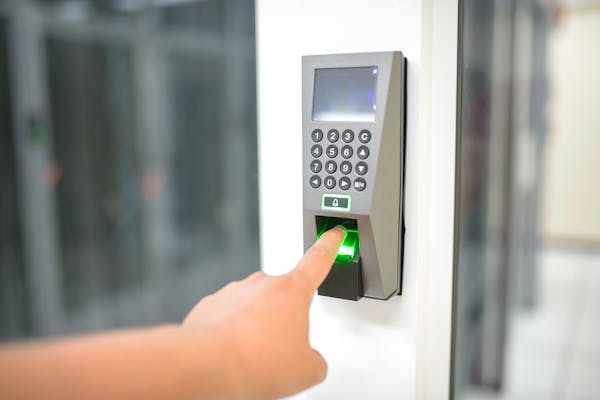In the digital age, data security is paramount. As cyber threats evolve, so do the measures to counteract them. Among the various biometric authentication methods, fingerprint scanning has emerged as a reliable and widely adopted solution. This article explores how fingerprint scanner improves data security, its underlying technology, and its applications across different sectors. We’ll also discuss the benefits, potential challenges, and future prospects of this technology.
Understanding Fingerprint Scanning Technology
The Basics of Fingerprint Scanning
Fingerprint scanning involves capturing and analyzing the unique patterns of ridges and valleys on an individual’s fingertip. These patterns are highly distinctive, making fingerprints an excellent biometric identifier. The process of fingerprint scanning generally involves the following steps:
- Image Capture: A fingerprint scanner captures an image of the fingerprint.
- Feature Extraction: The scanner’s software identifies unique features within the fingerprint, such as minutiae points (ridge endings and bifurcations).
- Template Creation: The extracted features are converted into a digital template.
- Matching: The template is compared against stored templates to verify the individual’s identity.
Types of Fingerprint Scanners
Fingerprint scanners come in various forms, each with its own method of capturing fingerprint images:
- Optical Scanners: Use light to capture an image of the fingerprint.
- Capacitive Scanners: Measure electrical currents to create an image based on the ridges and valleys of the fingerprint.
- Ultrasonic Scanners: Use high-frequency sound waves to generate a detailed image of the fingerprint.
- Thermal Scanners: Detect the temperature differences between the ridges and valleys of the fingerprint.
How Fingerprint Scanner Improves Data Security
Enhanced Authentication
Fingerprint scanners provide a robust form of authentication. Unlike passwords or PINs, fingerprints are unique to each individual and cannot be easily duplicated or guessed. This uniqueness significantly reduces the risk of unauthorized access to sensitive data.
Reduced Risk of Data Breaches
Traditional authentication methods, such as passwords, are vulnerable to various attacks, including phishing, brute force attacks, and keylogging. Fingerprint scanners eliminate these risks because they require the physical presence of the user. This makes it much harder for cybercriminals to breach systems protected by fingerprint authentication.
Improved User Convenience
One of the significant advantages of fingerprint scanners is the balance between security and convenience. Users no longer need to remember complex passwords or carry tokens. A simple touch or swipe of a finger is all it takes to gain access, making it an efficient solution for securing data without compromising user experience.
Applications of Fingerprint Scanners in Data Security
Personal Devices
- Smartphones and Tablets: Modern smartphones often come equipped with fingerprint scanners, providing an additional layer of security for personal data, apps, and financial transactions.
- Laptops and Computers: Fingerprint scanners are increasingly integrated into laptops, offering secure login and access to sensitive files.
Financial Sector
- Banking: Banks use fingerprint scanners for secure customer authentication during transactions, reducing the risk of fraud.
- ATMs: Some ATMs are equipped with fingerprint scanners, ensuring that only the account holder can withdraw funds.
Healthcare
- Patient Identification: Fingerprint scanners help accurately identify patients, ensuring that their medical records are accessed and updated correctly.
- Access Control: Healthcare facilities use fingerprint scanners to control access to restricted areas, protecting sensitive medical data.
Government and Law Enforcement
- Border Control: Fingerprint scanners are used at border crossings to verify the identity of travelers, enhancing national security.
- Criminal Identification: Law enforcement agencies use fingerprint databases to identify suspects and solve crimes.
Benefits of Fingerprint Scanners in Data Security
High Accuracy and Reliability
Fingerprint scanners offer high accuracy in identifying individuals. The likelihood of two individuals having identical fingerprints is extremely low, making this technology highly reliable for authentication purposes.
Quick and Seamless Integration
Fingerprint scanning technology can be easily integrated into existing security systems. Many devices now come with built-in fingerprint scanners, simplifying the adoption process for both individuals and organizations.
Cost-Effective Solution
While the initial investment in fingerprint scanning technology might be higher than traditional methods, the long-term benefits outweigh the costs. Reduced data breaches, lower fraud rates, and enhanced user convenience lead to significant savings over time.
Compliance with Regulatory Standards
Many industries are subject to strict data protection regulations. Fingerprint scanners help organizations comply with these regulations by providing a secure and reliable method of authentication, thus avoiding hefty fines and legal issues.
Challenges and Limitations
Privacy Concerns
Despite their advantages, fingerprint scanners raise privacy concerns. Biometric data, once compromised, cannot be changed like passwords. Ensuring the secure storage and transmission of fingerprint data is crucial to maintaining user trust.
Vulnerability to Spoofing
Although difficult, fingerprint scanners can be spoofed using high-quality replicas. Advances in technology are addressing this issue by incorporating liveness detection and other anti-spoofing measures.
Environmental Factors
Fingerprint scanners can be affected by environmental factors such as dirt, moisture, or injuries to the finger. These factors can impact the scanner’s ability to accurately capture and match fingerprints.
Future of Fingerprint Scanning Technology
Advancements in Sensor Technology
Ongoing research and development in sensor technology aim to enhance the accuracy and reliability of fingerprint scanners. Innovations like in-display fingerprint sensors and multi-modal biometrics are set to revolutionize the field.
Integration with Other Biometric Methods
Combining fingerprint scanning with other biometric methods, such as facial recognition or iris scanning, can provide multi-factor authentication, significantly improving security.
Expansion into New Sectors
As technology advances, fingerprint scanners are likely to find applications in new sectors. Potential areas include automotive security, smart home devices, and more, broadening the scope of how fingerprint scanner improves data security.
Conclusion
Fingerprint scanners have proven to be a valuable tool in enhancing data security. Their ability to provide accurate, reliable, and convenient authentication makes them an ideal choice for protecting sensitive information across various sectors. As technology continues to evolve, we can expect even greater advancements in fingerprint scanning, further solidifying its role in the landscape of data security.
The benefits of fingerprint scanners in improving data security are manifold. From personal devices to large-scale government applications, fingerprint scanning technology offers a robust solution to the ever-growing challenges of cyber threats. While there are challenges to address, such as privacy concerns and vulnerability to spoofing, the overall impact of fingerprint scanners on data security is undeniably positive.
In summary, understanding how fingerprint scanner improves data security is crucial in today’s digital world. By leveraging this technology, individuals and organizations can significantly enhance their security posture, protecting valuable data from unauthorized access and cyber-attacks. As advancements continue, the integration of fingerprint scanners with other emerging technologies will pave the way for a more secure and efficient future.















